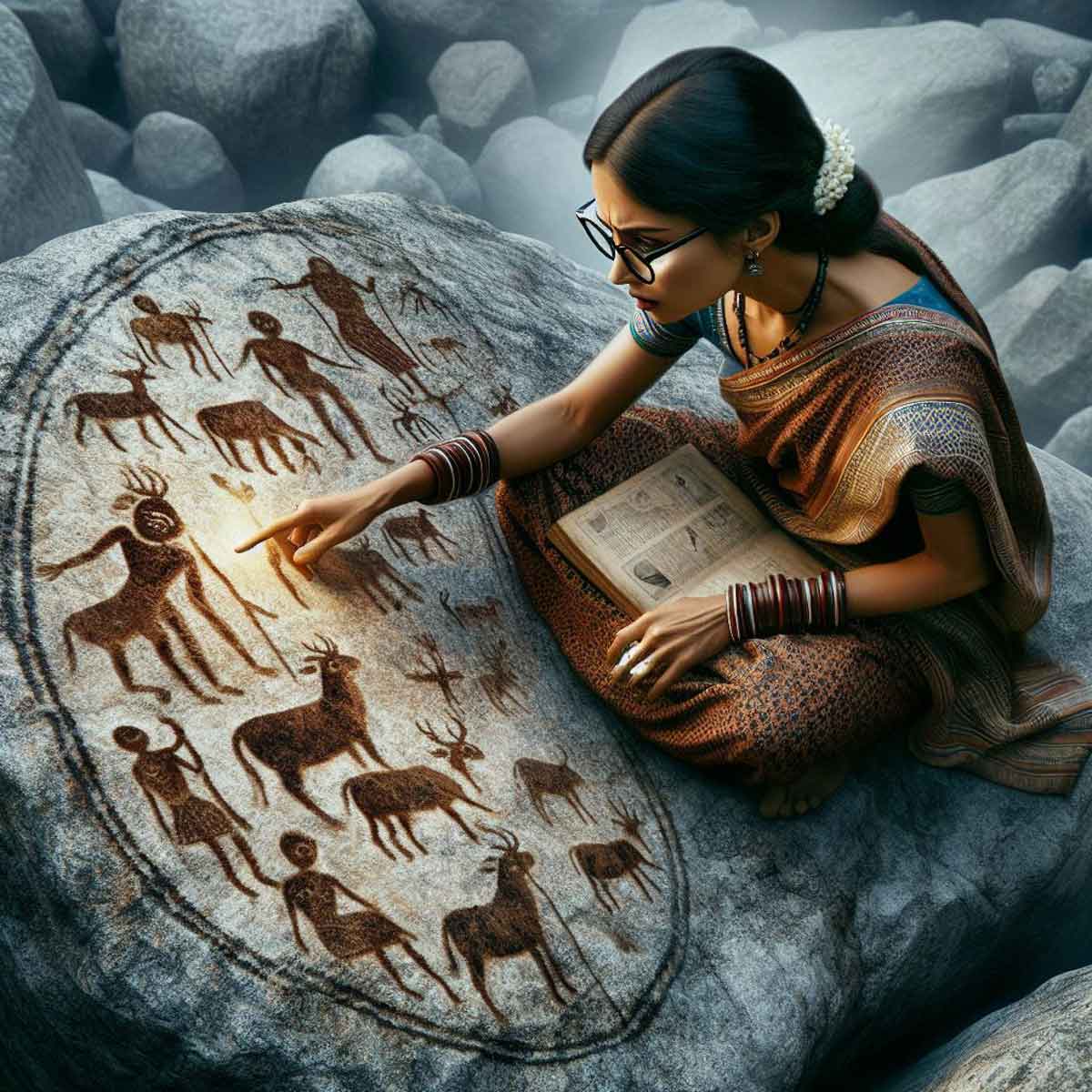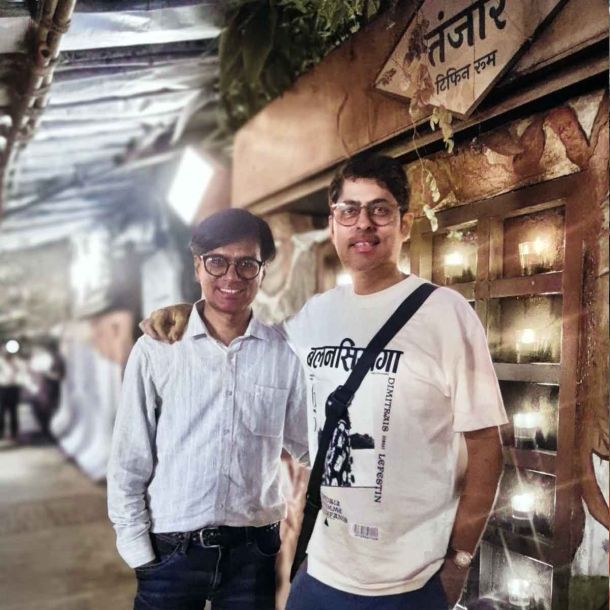More Coverage
Twitter Coverage
Satyaagrah
Written on
Satyaagrah
Written on
Satyaagrah
Written on
Satyaagrah
Written on
Satyaagrah
Written on
JOIN SATYAAGRAH SOCIAL MEDIA
Karnatak University Dharwad's groundbreaking find in Uttara Kannada uncovers a massive prehistoric rock art site, dating from 1,800 BC-200 AD, featuring unprecedented engravings, marking a monumental discovery in India's archaeological & cultural history

In a recent discovery, a group of researchers from Karnatak University Dharwad has pinpointed a significant site showcasing ancient rock art in Kalluru, situated within Bhatkal taluk of Uttara Kannada. This discovery marks a notable achievement in the field of historical and archaeological studies.
|
The expedition, steered by Jagadish Asode and Madhuri Chougule from the university's Department of History and Archaeology, successfully uncovered this site. The site, known as Barakolboli, lies discreetly one kilometre away from Karuru and six kilometres from the more renowned Murudeshwar.
This discovery is hailed as a milestone due to the sheer scale and significance of the rock engravings found. The site features an impressive collection of 20 engravings made on laterite, a type of iron and aluminium-rich soil. Such extensive and prominent rock art, particularly in the laterite zones of the coastal regions, has been rare, not only in Karnataka but also in neighboring Goa.
Experts in the field are considering this site as "the biggest and an important pre-historic site in the coastal belt as such a big rock art site with 20 engravings in laterite belt have been hardly noticed in any coastal sites of Karnataka and Goa." The discovery not only sheds light on the artistic expressions of ancient civilizations in this region but also opens up new avenues for research in prehistoric archaeology and history.
The site encompasses an area of 13 meters in length and 20 meters in width. Here, one can find an astonishing collection of 20 rock engravings. These engravings depict various forms, including human figures and animals like deer and bullocks, skillfully carved into the laterite ground. The artists have grouped these images into four distinct sections, showing their advanced planning and artistic thought.
Remarkably, the engravings maintain a consistent uniformity in width and depth, indicating the craftsmen's precision and care. The first group of carvings includes a fascinating array of figures: a standing human, bullocks, deer, and an archer. The human figure, notable for its size, stands at 1.65 meters tall and 1.25 meters wide, presenting a unique form with a circular head turned towards an upraised right hand.
|
This right hand dangles freely, with a long rope extending from it, connecting to a bullock positioned to the right of the figure. Intriguingly, the same rope appears to extend downwards, directly connecting to an archer depicted below the human figure. Adding to the scene's complexity, two circular potholes of shallow depth have been carved out, one near the human figure's head and another by its feet, suggesting some symbolic or functional purpose.
Further down, below the archer, there is another circular pothole. This pothole is part of a larger depiction, where a rope connects it with the hole near the archer and extends to another figure. This latter figure, adorned with two long, backward-sweeping horns and a distinctly elongated body, measures 87 centimeters in length. Its elongated form and features suggest it is a deer, adding another layer of depth to the narrative or ritual significance captured in these ancient engravings.
Beneath the deer engraving, the scene continues with two animals, one stacked above the other. The upper animal is larger and might represent another deer, although its head lacks clear definition. Its body, rectangular in shape, features a deep pothole near the hind leg, adding a sense of depth and complexity to the artwork. Directly below, a bullock is depicted, with a notable pothole positioned near its face, suggesting a thematic or symbolic link between the elements.
In the second group, the focus is on deer, each meticulously carved with a pothole positioned strategically between their legs. These deer are detailed with horns, one of which branches out, adding to their lifelike portrayal. Accompanying these is a fawn, placed below the larger deer figures, contributing to the narrative or ritual scene depicted. Not far from this, near the significant human figure's right side, stands a bullock, complete with a hump, tail, and horns, further enriching the tableau.
The narrative extends into the fourth group, where an arrangement of cup marks forms a notable pattern. Here, three pairs of these marks are aligned vertically, with each pair consisting of six cup marks, suggesting a methodical and symbolic placement.
In total, the site boasts 20 figures, encompassing two human beings, two bullocks, and 27 deer. The stylistic treatment of these figures, with curved end lines and anatomical features reminiscent of prehistoric art, gives clues to their ancient origins. The legs, body, tails, and faces of these creatures bear the hallmark traits of prehistoric artistic expressions.
Scholars are attempting to date these works, using the stylistic nuances of the engravings as a guide. The careful analysis of the forms, styles, and motifs plays a crucial role in understanding the timeline and cultural context of this impressive archaeological find.
The artistic style of the animal engravings at the site bears a striking resemblance to those found in the Neolithic-Chalcolithic period, spanning from 1,800 BC to 800 BC. This connection provides invaluable insights into the artistic evolution and cultural practices of the time.
Notably, some deer engravings are reflective of the Iron Age megalithic period, dated between 1,000 BC and 200 AD, showcasing a continuity or perhaps an overlap in artistic traditions. Moreover, the large human figure unearthed at the site is believed to mirror the art style of the early historic period, which is around 100 BC to 200 AD, offering a glimpse into the artistic expression of that era.
The ongoing research at this rock art site promises to uncover more about the historical and cultural narrative of the region. The investigative team has been conducting this detailed study under the esteemed guidance of retired professors R.M. Shadakshariah and S.K. Kallolikar.
In the course of their work, the team received valuable support from several distinguished individuals. S.K. Vasudeva, the Deputy Director of Archaeology, Museums and Heritage in Mysuru, Senior Assistant Director at the Department of Archives, Manjula Yaligar, and Aditya Hegde, an Assistant Lecturer in the Department of History and Archaeology at Karnatak University, played pivotal roles in the research. Additionally, the local resident Timmanna Gonda was mentioned for his assistance in the project, highlighting the collaborative effort that has characterized this significant archaeological endeavor.
 |
 Support Us
Support Us
Satyagraha was born from the heart of our land, with an undying aim to unveil the true essence of Bharat. It seeks to illuminate the hidden tales of our valiant freedom fighters and the rich chronicles that haven't yet sung their complete melody in the mainstream.
While platforms like NDTV and 'The Wire' effortlessly garner funds under the banner of safeguarding democracy, we at Satyagraha walk a different path. Our strength and resonance come from you. In this journey to weave a stronger Bharat, every little contribution amplifies our voice. Let's come together, contribute as you can, and champion the true spirit of our nation.
 |  |  |
| ICICI Bank of Satyaagrah | Razorpay Bank of Satyaagrah | PayPal Bank of Satyaagrah - For International Payments |
If all above doesn't work, then try the LINK below:
Please share the article on other platforms
DISCLAIMER: The author is solely responsible for the views expressed in this article. The author carries the responsibility for citing and/or licensing of images utilized within the text. The website also frequently uses non-commercial images for representational purposes only in line with the article. We are not responsible for the authenticity of such images. If some images have a copyright issue, we request the person/entity to contact us at This email address is being protected from spambots. You need JavaScript enabled to view it. and we will take the necessary actions to resolve the issue.
Related Articles
- Suhas Shetty, a Hindu, butchered on a Mangaluru street by a mob linked to banned PFI as people watched in silence—under Congress-ruled Karnataka, law and order collapses, 22 KSRP platoons now guard a city where Hindus are hunted in daylight
- Karnataka CM Siddaramaiah approves ₹398 crore for Muslim colonies as his 2025 budget pours crores into Urdu schools, Waqf, Haj Bhavan and scholarships in full-blown appeasement politics
- "देश के दुश्मन": Waqf Board claims 53 ASI monuments in Congress-ruled Karnataka, including Gol Gumbaz & Ibrahim Rauza; 43 sites in Vijayapura face encroachments, unauthorized repairs and lost tourism, defying Union Culture Ministry's directives since 2007
- "A reform is a correction of abuses; a revolution is a transfer of power": Historic mistake corrected - Karnataka BJP govt renames 'Salaam Aarti' started by Islamic tyrant Tipu Sultan to 'Namaskara', Hindu organizations long pending demand fulfilled
- In Shikaripura, Karnataka, 23-year-old Susheel was brutally stabbed by four individuals, including Zeeshan and Mubarak, for opposing bicycle stunts, highlighting escalating communal tensions and questioning law enforcement under the Congress regime
- Karnataka erupts in political turmoil as BJP slams Congress for 'Land Jihad', alleging valuable land given to minorities for appeasement, protests intensify with 'Raj Bhavan Chalo' march against the govt's budget, highlighting deepening state tensions
- Bengaluru court orders suspended JD(S) MP Prajwal Revanna into SIT custody until June 6 following arrest at Bengaluru Airport for sexual abuse allegations; Ex-Karnataka CM Bommai stresses the need for a fair investigation, hinting at political motivations
- "इंशाअल्लाह": In a major operation, NIA raided 11 locations, including the home of retired headmaster Abdul and his software engineer son Sohail, revealing their financial links to the Rameshwaram cafe blast and alleged links with mastermind Abdul Matheen
- "कब तक चलेगा ऐसे": Mukesh Kumar brutally attacked by mob in Bengaluru for playing Hanuman Chalisa; Suleiman, and Shahnawaz arrested reluctantly; outrage swells as citizens demand action against police delay and fight back against rising communal tension
- "चश्मे बद्दूर": In Karnataka, Ayub ur Rehman arrested after a video of him flashing his penis to female students outside Jain College went viral, Asianet Suvarna news reports reveal that he targeted female students at various colleges throughout Bengaluru
- ASI opposed petition seeking restoration of Hindu and Jain temples inside the Qutub Minar complex, says 'no provision under which Worship can be started': Verdict reserved for June 9
- Karnataka: After VHP’s protest, govt withdraws decision to pay Muslim clerics from Hindu temple funds
- In a startling event, Bengaluru's Rameshwaram Cafe rocked by an IED explosion, injuring nine; authorities, including NIA, about to reach for probing, CCTV footage reveals a suspect leaving a bag, Dy CM Shivakumar says, "Low-intensity blast. Don't worry"
- In a chilling exposé, Karnataka police nabbed Muslim ASI Chan Pasha, Dr. Nagaraj, and Anees Fathima, mother of jihadist Junaid Ahmed, for helping Lashkar run a radical Islamist network using 100+ phones and ₹70 lakh from inside Bengaluru prison
- Udupi - FIR against Muslim students Alimatul Shaifa, Shabanaz, & Alia for filming Hindu girls, yet bail granted, contrastingly, a BJP woman's arrest for questioning the CM on the cover-up sparks debate on fascism and appeasement in the college controversy




























